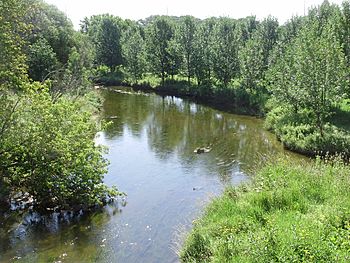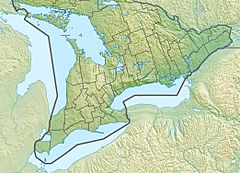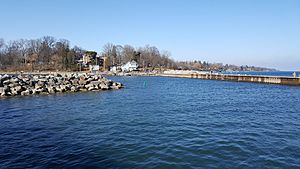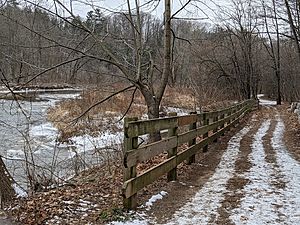Sixteen Mile Creek (Halton Region) facts for kids
Quick facts for kids Sixteen Mile Creek |
|
|---|---|

Sixteen Mile at Milton, Ontario
|
|
|
Location of the mouth of Sixteen Mile Creek in southern Ontario
|
|
| Native name | niizhozaagiwan ("having two outlets" in Mississauga) |
| Other name(s) | Rivière de Gravois ("gravelly river" in French) |
| Country | Canada |
| Province | Ontario |
| Region | Greater Toronto Area |
| Regional Municipality | Halton |
| Municipalities | Oakville, Milton |
| Physical characteristics | |
| Main source | wetland Milton 365 m (1,198 ft) 43°35′08″N 80°02′34″W / 43.58556°N 80.04278°W |
| River mouth | Lake Ontario Oakville 74 m (243 ft) 43°26′22″N 79°39′57″W / 43.43944°N 79.66583°W |
| Basin features | |
| River system | Great Lakes Basin |
| Basin size | 372 km2 (144 sq mi) |
Sixteen Mile Creek is a river in the Halton Region of Ontario, Canada. It is part of the Great Lakes Basin. The creek flows from the Niagara Escarpment through the towns of Milton and Oakville. It then empties into Lake Ontario.
The creek gets its name because its mouth is sixteen miles from the western end of Lake Ontario. The Mississauga people used to call it Ne-sauga y-onk or niizhozaagiwan. This means "having two outlets" in their language. The French called it Rivière de Gravois, which means "gravelly river".
Like many creeks that flow into Lake Ontario, Sixteen Mile Creek has carved a deep valley. This valley is home to many different animals. You might see whitetail deer, raccoons, foxes, opossums, and squirrels. The forest here has trees typical of the Carolinian forest. The total area of land that drains into the creek is 372 square kilometers.
In Oakville, the creek flows through parts of the Glen Abbey Golf Course. It is also where the Oakville Yacht Squadron is located.
Contents
Fishing Fun at Sixteen Mile Creek
Conservation Halton says that Sixteen Mile Creek is a great place to fish. You can find many fishing spots all along the creek's watershed in Oakville and Milton.
What Fish Can You Catch?
The west branch of the creek is excellent for coldwater fish. You can find brook, brown, and rainbow trout there. During spring and fall, you might even see chinook salmon swimming upstream to lay their eggs.
The Mill Pond near downtown Milton is a good spot for panfish and carp. Even though trout don't live there permanently, it's still a fun place to cast a line. The middle and east branches of the creek are good for smallmouth bass.
Near Lake Ontario, the lower parts of the creek are a pathway for fish from the lake. Oakville Harbour is a calm place to fish for trout and salmon before they swim up the creek. The rocky banks of the harbour are also a great home for smallmouth bass.
Exploring the Trails
The Town of Oakville has a great trail system along Sixteen Mile Creek. The Sixteen Mile Creek Trail runs along both sides of the creek. It is part of the 60-kilometer-long Oakville Heritage Trail network.
Discovering Oakville's History
These trails have information stations that tell over eighty stories. These stories are about the land and its people, going back to 9000 BC. The trails connect different parts of the community. They show Oakville’s natural beauty, history, and buildings.
The Heritage Trails were created as a special project for the new millennium. In 2017, new trail projects were finished. These included a new station honoring Indigenous heritage. This was part of Canada's 150th Birthday celebrations.
The Moccasin Trail: A Special Path
The Moccasin Trail is a part of the Sixteen Mile Creek Trail. It's a 6.1-kilometer loop that is good for all skill levels. The trail starts where the land drops sharply because of Queenston shale cliffs. This makes the trail along the riverbank hard to pass.
A Journey Through Indigenous Heritage
The rest of the Sixteen Mile Creek Trail follows the beautiful west riverbank. The Moccasin Trail covers almost half the distance between the Dundas bridge and the Glen Abbey Golf Course.
The Sixteen Mile Creek Moccasin Trail is one of two trails that honor Oakville’s rich Indigenous heritage. The other is on the Bronte Creek Heritage Trail. The Moccasin Trail Heritage Information Kiosk is near Rebecca Street and Mississauga Street.
These Moccasin Trails have 13 plaques with Indigenous stories, poems, and facts. They teach visitors about the land, water, and sky. This helps people understand Indigenous heritage better.
Keeping the Creek Healthy: Invasive Plants
Some plants that are not native to the area can cause problems. These are called invasive plants. They can harm the local environment and even people.
Watch Out for Harmful Plants
Giant hogweed is an invasive plant found along Sixteen Mile Creek. If you touch this plant, it can cause serious burns to your skin. It can also cause temporary or even permanent blindness.
Wild parsnip is another invasive plant. Its sap can make your skin react badly to sunlight. This can cause severe burns, rashes, or blisters. European settlers brought these plants to North America for their edible roots. But they escaped from gardens and now grow in the wild.
How to Help Protect the Creek
The Town of Oakville takes care of the trails around Sixteen Mile Creek. They run campaigns to teach people about invasive plants. Here are some ways you can help:
- Learn how to identify invasive plants.
- Stay on the trails and away from areas with these plants.
- Check your clothes, pets, bikes, and tools for mud, seeds, or plant parts. Clean them off before you leave.
- Avoid digging up plants or disturbing the soil in natural areas.




